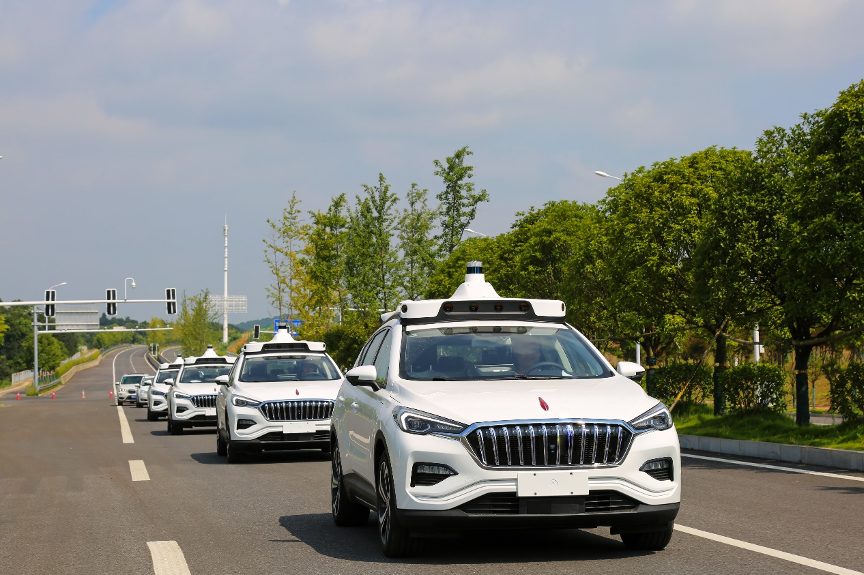Building roads before sports cars is China’s fastest low-cost channel for autonomous driving.
Editor’s note: This article comes from “ Future Car Daily ” (WeChat public account ID: auto-time), author: Xiao Cheng Yi.
Author | Cheng Xiaoyi
Edit | Xu Yang
Baidu is going to “build a road”.
On March 24, Baidu Apollo won the bid again for the new infrastructure project and will participate in the construction of a two-way 10km two-way car-road demonstration zone in Yangquan Economic Development Zone. The project will complete the construction of roadside systems and the deployment of a vehicle-road collaborative cloud control platform and an autonomous vehicle monitoring platform based on Baidu’s public cloud deployment. This project has a long history. As early as November 21, 2019, Baidu Apollo announced that its autonomous driving and vehicle-road collaboration project will be launched in Yangquan, Shanxi.
The Yangquan project is a new infrastructure project that Baidu Apollo won the third “official announcement” in March this year. The first two were, on March 23, Baidu won the bid for the 5G Chelu Road Demonstration Line Project in Tangxihe Park, Hefei, with a total bid of approximately 29.15 million yuan. On March 17, Baidu won the bid for the “Western Autonomous Driving Open Test Base” project in Yongchuan District, Chongqing, with a total bid amount of 52.8 million yuan.

Tongxihe Park 5G Demonstration Operation Line Planning for Intelligent Networked Cars Source: Baidu Apollo
The concentrated investment efforts of local governments in March were mainly based on clear instructions from the central government. Since February this year, the central government has advocated the deployment of “new infrastructure” and mentioned relevant content 4 times within 20 days. On March 4, the Standing Committee of the Political Bureau of the Central Committee of the Communist Party of China held a meeting and proposed to accelerate the construction of new infrastructure such as 5G networks and data centers. In the road reconstruction, Miao Wei, Minister of Industry and Information Technology, once said, “In China, we resolutely promote 5G LTE-V2X (Internet of Vehicles) in road reconstruction.
The LTE-V2X car network includes V2V (car-car), V2I (car-infrastructure), V2N (car-internet), and V2P (car-pedestrian), that is, carsRoad coordination is an important part of urban smart transportation. Uber test car accidents and Tesla autopilot accidents in foreign countries all have visual blind spots in bicycle sensing systems. Vehicle-road coordination not only allows cars to perceive road conditions, but also allows traffic participants (infrastructure, pedestrians) to grasp the direction and intention of cars, greatly improving the driving safety factor of smart cars.
The strategic position of vehicle-road collaboration is self-evident, and its corresponding market is no longer blue ocean. Baidu and Ali have begun secret competitions as early as 2018, and Huawei and Tencent followed shortly after respectively releasing commercial V2X chip-level solutions and 5G vehicle road collaborative open source platforms.
Why Baidu took the lead in winning the bid for the new infrastructure in this powerful rivalry competition?
Baidu has the advantage of “car end”
BATH has a coordinated layout of vehicles and roads, but the development focus is different.
“Baidu emphasizes autonomous driving, and Ali’s focus is on smart transportation and monitoring.” An autonomous driving company executive told Future Auto Daily (ID: auto-time) that the two collaborations have different purposes. Baidu focuses on driving. Ali focuses on monitoring.
As the earliest Internet company in China that researches and develops autonomous driving, Baidu’s road-to-road collaborative thinking is based on “cars” and aims at the application needs of autonomous vehicles to develop roadside sensing capabilities and optimize V2X communication and roadside sensing capabilities . Baidu Apollo’s self-driving fleet has obtained self-driving road test licenses in Beijing, Changsha, Chongqing, Fujian and other places, and its road test mileage ranks first in China.

Baidu autonomous driving team Source: Baidu Apollo
Alibaba’s road-to-road collaboration ideas start from the “road”. Based on his rookie alliance scene and the accumulation of road information in the ET city brain, Ali has more data and ability to perceive road conditions. On September 6, 2018, Alibaba Dharma Institute and the Highway Science Research Institute of the Ministry of Transport established a joint vehicle-road collaboration laboratory, which proves Ali’s advantage at the road end.
Tencent and Huawei’s car-road collaboration are cut from C-terminal users and communication terminals. The three new infrastructure projects won by Baidu mentioned above are aimed directly at self-driving car testing and landing operations.In comparison, cooperation with Baidu Apollo is more suitable.
In addition, Baidu has already achieved results in the field of vehicle-road collaboration. In October 2018, Baidu and the Changsha Municipal Government announced a co-construction “Autonomous Driving and Vehicle-Road Collaborative Innovation Demonstration City”. Two months later, its L3 / L4 class passenger cars, commercial vehicles, sweepers and logistics vehicles and other all-scenario models have completed a multi-model high-speed scene-road collaborative demonstration in Changsha.
From the perspective of Baidu, the adjustment of the internal organizational structure has heralded that Baidu’s Apollo’s business focus is tilting towards vehicle-road collaboration.
In December 2019, Baidu’s Intelligent Driving Group (IDG) undertook the first organizational structure upgrade since its establishment three years ago. Among them, the intelligent car business unit was downgraded and merged into the autonomous driving business unit, and the vehicle-road collaboration unit was upgraded to an independent department, which is the intelligent transportation business unit.

Changes in the organizational structure of Baidu’s intelligent driving business group Source: Shenzhen-Hong Kong Securities Research Institute
At its Apollo Eco-Conference, Baidu explicitly built the Apollo ecosystem on the basis of three open platforms: vehicle-road collaboration, autonomous driving, and smart car linkage. The new department focuses on the intelligent upgrade of transportation infrastructure and provides cities with next-generation intelligent transportation solutions such as vehicle-road collaboration systems and regional intelligent signal optimization systems. The Apollo 5.5 released at the conference also added a deep learning method to help autonomous vehicles quickly learn traffic rules and understand the road surface environment.
Vehicle-road collaboration This type of new infrastructure industry is different from the Internet. The scarcity of road engineering is that it is difficult to have multiple contractors on a road at the same time. Although the entry point of BATH is different, but the same route is the same, the nature of the competition between the road and the road is still “horse racing.” At present, cities such as Changsha, Chongqing, Cangzhou, Zhuzhou, Hefei, and Yangquan have reached cooperation with Baidu Apollo. Baidu has the first mover advantage.
Build the road first, then the sports car
In the field of autonomous driving, domestic and foreign have run different development routes. The vehicle-road collaboration represented by Baidu Apollo in China is represented by Waymo, a self-driving company owned by Google ’s parent company.Bicycle intelligence.
This has to do with transportation development in different countries.
Autonomous driving vehicle classification standards issued by the American Society of Automotive Engineers SAE in 2014 are regarded as the universal standard in the field of autonomous driving, but the classification of road intelligence in the United States is not clear. Moreover, the construction of 5G base stations in the United States is far inferior to that of China. According to data from the German data company IPlytics, before August last year, China had deployed about 350,000 5G base stations, about 10 times that of the United States. In terms of 5G base station construction, it is expected that US operators will pay 5 times as much as China .
Waymo, native to the United States, is more inclined to gradually improve the autonomous driving capabilities of individual vehicles through the stacking of sensors and the optimization of algorithms. In addition, because the U.S. is vast and sparsely populated, the transportation environment is relatively simple, and most large parking lots in commercial districts do not charge, and places that are not clearly marked on the roadside can be parked at will.

Waymo unmanned car Source: Waymo official website
Waymo’s self-driving cars can achieve short-term waiting in these places, but the rules of each business district in Chinese cities are slightly different, and bicycles are difficult to cope with.
But bicycle intelligence has two key issues. On the one hand, the continuous stacking of sensors will make the cost of bicycles high. This is one of the reasons why Waymo gave up the production of self-driving cars for C-end sales. On the other hand, the perception of bicycles will always be due to the obstruction of the front car or the road. There are blind spots in depressions and protrusions, which have hidden safety hazards. After the trial of the car-road collaboration technology on the domestic smart highway Wuxi Shuofang-Dongqiao section, the number of traffic accidents in May 1st holiday in 2019 was reduced by 77.3% compared to 2019, and the average congestion distance was reduced by 33.3%, with significant effects.
Building a road first, then a sports car, at first glance may seem like a curve to save the country’s ability to save the country, but it is actually the fastest low-cost channel to achieve autonomous driving.
At the Changsha Yuelu Summit in April last year, Baidu CEO Li Yanhong proposed three realms of intelligent networking: the first realm is the intelligentization of transportation infrastructure, and the second realm is the autonomous driving of limited scenarios (such as autonomous Parking), the third realm is the ultimate realization of unmanned driving. It can be seen that Baidu’s focus on vehicle-road collaboration is an inevitable strategy.
For local governmentsIn other words, vehicle-road synergy is a long-cycle, long-industry chain industry. The introduction of high-tech companies is to pave the way for the overall upgrading of the local industry. Guoxin Securities estimates that in the application scenarios of intelligent intersections, urban roads, highways, etc., the market for vehicle-road collaboration equipment can reach hundreds of billions of magnitude, and the medium-term market space for LTE-V RSU equipment can reach approximately 50 billions of magnitude.
